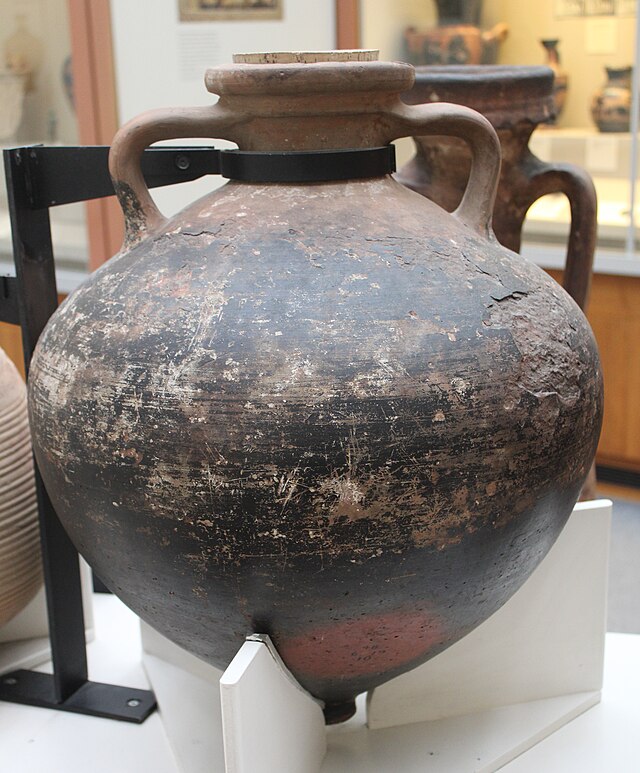Introduction
The Greek amphora stands as a testament to the artistic prowess and cultural significance of ancient Greece. These remarkable vessels, used for various purposes, showcase the craftsmanship and creativity of the ancient Greek civilization. In this article, we will delve into the captivating world of Greek amphoras, exploring their history, design, uses, and enduring legacy.
History of Greek Amphoras

Greek amphoras have a fascinating history that spans several centuries. They first emerged during the 8th century BCE and experienced their heyday during the Archaic and Classical periods of ancient Greece. These vessels played a vital role in various aspects of Greek life, particularly in trade and commerce.
During this time, Greece was a seafaring nation with an extensive network of trade routes that stretched across the Mediterranean. Greek merchants relied heavily on amphoras to transport valuable goods such as wine, olive oil, grains, and other commodities. The design of the amphora was well-suited for maritime transportation, with its narrow neck and two handles allowing for easy handling and stacking.
Amphoras were produced by skilled potters who carefully crafted these vessels by hand. They used local clay and employed various techniques such as wheel throwing and hand-building to shape the amphoras. Once shaped, the vessels were often decorated with intricate designs, showcasing the artistic talent of the Greek craftsmen.
The design and decoration of Greek amphoras evolved over time, influenced by changing tastes, trade patterns, and cultural influences. In the earlier periods, the decorations were simple and geometric in nature, featuring repetitive patterns and abstract motifs. However, as Greek civilization progressed, the designs became more elaborate and began to depict scenes from mythology, historical events, and daily life. The imagery on the amphoras provided a visual narrative and reflected the cultural and social values of the time.
Archaeological excavations have unearthed numerous Greek amphoras, providing valuable insights into ancient trade and commerce. These vessels were often found in shipwrecks, indicating their role in maritime trade and the significance of the goods they carried. The study of amphoras and their distribution across different regions has shed light on the extent of ancient trade networks, revealing the economic interconnectedness of the Mediterranean world.
Today, Greek amphoras continue to be admired for their historical and artistic value. They serve as tangible reminders of the rich cultural heritage of ancient Greece and provide a window into the daily lives and economic activities of its people. Museums worldwide house exquisite examples of Greek amphoras, allowing visitors to appreciate their beauty and learn about the fascinating history behind these remarkable vessels.
Design and Characteristics Greek Amphoras
Greek amphoras boast distinctive features that make them easily recognizable. Typically, they have an elongated body, narrow neck, and two handles for easy transportation. The body of an amphora is often adorned with intricate decorative motifs, showcasing scenes from mythology, daily life, or historical events. The designs are meticulously painted using vibrant colors, adding to the visual appeal of these vessels.
Types of Greek Amphoras

Greek amphoras exhibit a wide variety of shapes and styles, each with its unique characteristics and purposes. Here are some notable types of Greek amphoras:
- Neck Amphora: The neck amphora features a tall neck and an elongated body. It was primarily used for storing and transporting liquids such as wine, oil, and perfumes. The elongated neck provided a convenient pouring spout, while the handles allowed for easy carrying.
- Belly Amphora: The belly amphora has a rounded body, resembling an exaggerated belly shape. It was commonly employed for storing and transporting a wide range of goods, including grains, olives, and other non-liquid commodities. The rounded body allowed for efficient packing and stacking of amphoras during trade.
- Panathenaic Amphora: The Panathenaic amphora was a special type of amphora specifically created for the Panathenaic Games, held in Athens. These amphoras were given as prizes to the victors of the athletic competitions. They were often larger in size and elaborately decorated with scenes related to the Games and Greek mythology.
- Lekythos: While not technically an amphora, the lekythos is a slender, flask-shaped vessel commonly associated with funerary rituals. It was used to hold perfumed oils and was often placed in tombs as grave offerings. Lekythoi were usually decorated with scenes depicting mourning figures and symbolic representations of the afterlife.
- Krater: Although primarily used for mixing and serving wine, the krater can also be considered a type of amphora. It has a large, wide-mouthed body with two handles and a flat base. Kraters were often used in symposia, social gatherings where wine was mixed with water before being served.
These are just a few examples of the diverse range of Greek amphoras that existed. Each type served a specific purpose based on the nature of the goods they stored or the cultural context in which they were used. The designs and decorations on these vessels reflected the artistic trends and narratives of the time, providing valuable insights into ancient Greek culture and society.
Functions and Uses of Greek Amphoras
Greek amphoras served diverse functions in ancient society. Apart from their role in trade, they were used in religious ceremonies, as grave markers, and as prizes in athletic competitions. These vessels played a significant part in the daily lives of the Greeks, reflecting their cultural, economic, and social practices.
The Significance of Greek Amphoras in Trade
Greek amphoras played a crucial role in the Mediterranean trade network, facilitating the exchange of goods across different regions. The sturdy design of the amphoras ensured the safe transportation of valuable commodities, including wine, olive oil, and spices. Their presence in archaeological sites around the Mediterranean attests to the vast trade networks and economic prosperity of ancient Greece.
Depictions of Greek Amphoras in Art and Literature

Greek amphoras found their way into various forms of artistic expression. They were frequently depicted in paintings, sculptures, and pottery itself. These vessels often depicted scenes from mythology, heroic exploits, and historical events. Their artistic representation not only celebrated Greek culture but also provided valuable insights into the society and values of the time.
Preservation and Archaeological Discoveries of Greek Amphoras

Thanks to the durability of pottery, numerous Greek amphoras have survived the test of time. Archaeological excavations have unearthed countless examples of these vessels, allowing researchers to gain a deeper understanding of ancient Greek life. Museums worldwide proudly display these artifacts, providing visitors with a glimpse into the ancient past.
Collecting Greek Amphoras
The allure of Greek amphoras extends beyond the academic realm, attracting collectors from all over the world. These artifacts not only possess historical significance but also hold artistic value. Collectors avidly seek out Greek amphoras, appreciating their beauty and the tangible connection they provide to the ancient world.
Greek Amphoras in Modern Culture

Despite belonging to a bygone era, Greek amphoras continue to captivate the modern imagination. They inspire contemporary artists, designers, and architects, influencing their works with a touch of ancient elegance. Furthermore, replicas of Greek amphoras are often utilized as decorative pieces, adding a touch of antiquity and sophistication to homes and public spaces.
Conclusion
The Greek amphora stands as an enduring symbol of ancient Greek civilization. Through their elegant design and cultural significance, these vessels offer a gateway to the past, allowing us to appreciate the ingenuity and artistic talent of our ancestors. Whether admired in museums, collected by enthusiasts, or celebrated in contemporary art, Greek amphoras continue to inspire and fascinate, reminding us of the timeless beauty of human creativity.




rybelsus pill